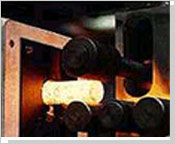 Forging technology occupies a very important place among all the manufacturing processes as it produces parts with excellent properties and with minimal wastage. Through a series of operations, metals with very simple geometry are physically deformed into products of complex configuration.
Forging technology occupies a very important place among all the manufacturing processes as it produces parts with excellent properties and with minimal wastage. Through a series of operations, metals with very simple geometry are physically deformed into products of complex configuration.
In the forging process the metal is heated up by applying compressive force and given shape by plastic deformation. The compressive force is applied by hammer blows using a power hammer or a press. Powered by compressed air, hydraulics electricity or steam. The weight of the hammer can be 500 pounds to thousands of pounds. Forging has the capacity to refine the grain structure and improve the physical properties of the metal.
Forging products are consistent, without the defects of porosity, inclusion or voids, finishing operations like machining and coating operations like painting or plating can also be done very easily.
Typically a forged metal results in the following:- Drawing Out of the Metal: Increased length decreased cross-section.
- Upsetting the Metal: Decrease in length decreased cross-section.
- Change in Length; Change in Cross-section: Resulting in favourable grain flow for strong parts.
Tips for Selecting the Right Forging Technology
- Technology to remain competitive must come out with cost effective alternatives. That is the reason computer aided techniques like CAD, CAM, CAE and Finite Element Analysis (FEA) based computer simulation, are used to selecting the right forging process.
- Understanding the forged material's flow behaviour under processing conditions.
- Knowledge of the die geometry and materials.
- Environmental considerations.
- Evaluating the mechanics of deformation process-stress and strain.
- Friction and Lubricating process.
- Nature of the Forging equipment.
Applications of Forging Process:
Wide variety of uses in different kinds of Industries:
Automobile Industry: Wheel spindles, kingpins, axle beams and shafts, torsion bars, ball studs, idler arms and steering arm.
Agro-Industries: Engine and transmission components, levers, gears, shafts and spindles to tie-rod ends, spike harrow teeth and cultivator shafts.
Aerospace: Bulkheads, hinges, wing roots, engine mounts, brackets, beams, shafts, landing gear cylinders and struts, wheels, brake carriers and discs and arresting hooks, blades, buckets couplings etc.
Hand Tools: Sledges, pliers, hammers, wrenches and garden tools, as well as wire-rope clips, sockets, hooks, turnbuckles and eye bolts are common examples.
Industrial Equipment: Connecting rods, blanks, blocks, cylinders, discs, elbows, rings, T's, shafts and sleeves.
Methods of Forging